


mentioned surface decoration. Late medieval architecture is a delight to the eye of the viewer who likes complex patterns and a riot of color (medieval cathedrals were originally
entirely
and exuberantly painted; only later ideas of "purity" and
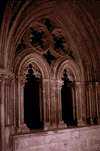
"taste"--and hours of whitewash or scraping--have robbed
us of the decoration)
Imagine a gothic window like this one at Batalha, in Portugal, entirely
painted, with a different color to every rib, some striped or patterned.
Then imagine the light of a stained glass window falling across it.
Psychedelic!
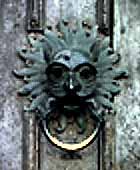
Another decorative detail
is this famous "sanctuary knocker" on the door of Durham
Cathedral, in the north of England (if an accused man could reach the
church, even if he only got as far as the door, he could cling to the
knocker and claim the "sanctuary" or safety of the
Church).
 urface
urface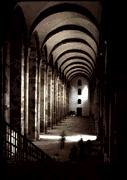 decoration isn't
the whole story, however. The sheer power of these enormous structures
is best expressed in their proportions. To an eye dazzled by elaborate
pattern, the appreciation of proportion might seem a bit austere,
but its power is very real. Like the nave of Wells Cathedral (which
you can see in the next section below), this aisle of the
decoration isn't
the whole story, however. The sheer power of these enormous structures
is best expressed in their proportions. To an eye dazzled by elaborate
pattern, the appreciation of proportion might seem a bit austere,
but its power is very real. Like the nave of Wells Cathedral (which
you can see in the next section below), this aisle of the 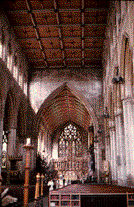 cathedral at Speyer (at the
right), in western Germany (much smaller than the nave of the church)
can have a severely monumental beauty. Proportion can be impressive
even in smaller churches, as in this parish church of St. Botolph's
in Boston (and you thought that was in America), with
cathedral at Speyer (at the
right), in western Germany (much smaller than the nave of the church)
can have a severely monumental beauty. Proportion can be impressive
even in smaller churches, as in this parish church of St. Botolph's
in Boston (and you thought that was in America), with 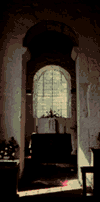 its high ceiling, crafted of chestnut by England's
famous medieval carpenters. Proportion even operates in a tiny medieval
church like the one at Bradford on Avon (upstream from Stratford),
built in the tenth? century. The odd but interesting proportions of
the doorways silence me and make me feel as if I am in the presence
of builders greater than any living today because of the builders'
powerful conception of building space.
its high ceiling, crafted of chestnut by England's
famous medieval carpenters. Proportion even operates in a tiny medieval
church like the one at Bradford on Avon (upstream from Stratford),
built in the tenth? century. The odd but interesting proportions of
the doorways silence me and make me feel as if I am in the presence
of builders greater than any living today because of the builders'
powerful conception of building space.

 ost
cathedrals are cross shaped, so the place where the nave (the long part)
met the transcepts (the short part) was often very dark. Medieval builders
of some cathedrals met that challenge by designing a crossing tower with
windows,
ost
cathedrals are cross shaped, so the place where the nave (the long part)
met the transcepts (the short part) was often very dark. Medieval builders
of some cathedrals met that challenge by designing a crossing tower with
windows, 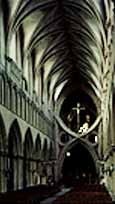 like this one at the church
of St. Etienne at Caen (Normandy), to flood that
large dark area with light.
like this one at the church
of St. Etienne at Caen (Normandy), to flood that
large dark area with light.
Sometimes the weight of the crossing
tower created disastrous problems, as at one of my favorite cathedrals.
Wells Cathedral has magnificent "strainer arches" that were
added to strengthen the church at the crossing, which was beginning
to buckle in the late Middle Ages. These "scissor arches"--there
are two more at right angles--look modern, but they are a daring and
monumental solution to a structural problem that dates to the fourteenth
century. I love them.

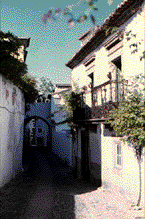 nly
long after I had travelled on the Continent and throughout England did
I discover that medieval houses in towns and cities coexisted with the
cathedrals and palaces I had seen. Some were in tiny mountaintop villages
off the beaten track, like these in the Portugese fortified village of
Marvaõ (the local inn has nine rooms). Others, perhaps more reminiscent
of Dante and Boccaccio, still
nly
long after I had travelled on the Continent and throughout England did
I discover that medieval houses in towns and cities coexisted with the
cathedrals and palaces I had seen. Some were in tiny mountaintop villages
off the beaten track, like these in the Portugese fortified village of
Marvaõ (the local inn has nine rooms). Others, perhaps more reminiscent
of Dante and Boccaccio, still 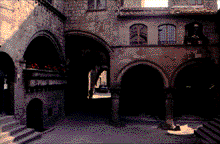 stand in Italy, like this one, built around an open courtyard in Viterbo, a town much frequented by medieval popes.
;
stand in Italy, like this one, built around an open courtyard in Viterbo, a town much frequented by medieval popes.
;